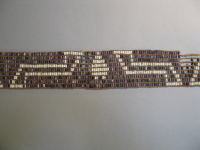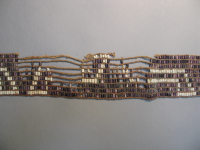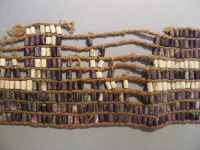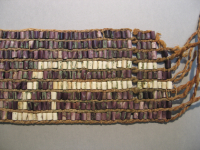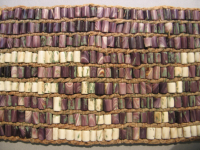Double Calumet Treaty Belt
Double Calumet Treaty Belt
Double Calumet Treaty Belt


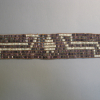


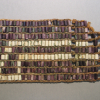
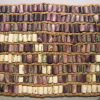
A wampum belt with triangle and double calumet motifs. Of Huron (Wendat) origin. Probably relating to a treaty between the Huron (Wendat) Confederacy and the Tobacco (Tionontate) Nation in 1637. One of four wampum belts collected by Horatio Hale and purchased from him by Professor Edward Burnett Tylor. Donated to the Pitt Rivers Museum by Tylor in 1896.
The Pitt Rivers Museum Object Catalogue record describes this item as "Wendat."
Pitt Rivers Museum accession record and observations made by the GRASAC research team.
Read More About This Relative
wampum, purple and white shell; apocynum (nettle stalk fibre) twine; paint, green and red.
This belt was made by loom weaving. It has ten warp threads and nine rows of dark purple shell beads. CW notes the beads are of uneven sizes. The end of the longest warp thread on the left side is knotted, but the other ones are not tied. It is as if they were cut off. On the right side, none of the ends are tied. It may once have been longer, perhaps symmetrical.
The central motif is a triangular shape that may represent a tree of peace. Three double calmuets appear to the left of the tree, and four on the right.
Horatio Hale called this belt "The Double Calumet Treaty Belt." The GRASAC research team said the central motif may not be a tree of peace. JM has never seen it with what appears to be two trunks. HB said the triangular motif looks like an upside down heart. RP noted that we have no evidence of pre-contact wampum. It seems to have come into being at a time when communication with non-Aboriginal people was needed. Also, it became possible to mass-produce wampum beads which increased supply. From these two factors, the wampum developed as a form of communication. It came out of a blending of Aboriginal oral tradition and visual representation. At this time of communication experimentation, could people have been experimenting with visual forms of communication as well? HB wondered if it was possible that belts were made by re-using wampum taken from older belt? We do know the material was rare. JM noted the asymmetrical layout of the double calmuets (three on left, four on right) seems odd, given that wampum is usually symmetrical. The strings are quite long on the side with the three double calumets.
Horatio Hale's own description, in "Four Huron Wampum Records: A study of Aboriginal American History and Mnemonic Symbols" (1897) states, "[t]he double calumets seem to have been originally eight, one having been lost from one end, as another has partially disappeared from the other extremity... It seems likely that the eight calumets had reference to the eight clans or gentes, who composed the Huron people, and were found in different proportions in all the tribes" (237).
CW wondered if this particular method of weaving was Indigenous. RP noted that finger-weaving was around before contact. LP and RP said the reddish deposits could be ochre that has turned green. CW suggested the reddish deposits could be vermillion. Vermillion was available through trade and used as replacement for ochre, as early as the 1740s. Knowing whether the material is ochre or vermillion may help to date the item. She also noticed that the green and red deposits appear to have originally covered both sides of the entire belt, beads and twine. LP wondered if nettle stalk fibre commonly used in the making of wampum belts. RP suggested that locating accounts of ochre use on wampum could help with dating the object, and that going over documentation of wampum belts (i.e. Lafitau, Jesuit Relations) could help us learn more about ochre/wampum application. Anne Gunnison, conservation Intern at the Pitt Rivers Museum, plans to do an ID analysis of the green residue 2008.
The Pitt Rivers object catalogue states that the item probably relates to a treaty between the Huron (Wendat) Confederacy and the Tobacco (Tionontate) Nation in 1637.
Provenance
Collected by Horatio Hale while at the Anderdon Reserve, which he visited in 1872 and 1874. The Pitt Rivers Object Catalogue entry states this is one of four wampum belts of the Hurons, collected by Mr. Horatio Hale and purchased from him by Prof. Tylor for 30 pounds. Chief Joseph White owned this belt before it was collected by Horatio Hale. This item was part of a larger donation of four wampum belts (1896.7.7, 1896.7.8, 1896.7.9, 1896.7.10) and a box of wampum beads (1896.7.11).
- Hale, Horatio. "Four Huron Wampum Records: A Study of Aboriginal American History and Mnemonic," Journal of the Anthropological Institute XXVI (1897): 221. - Tylor, E.B. "The Hale Series of Huron Wampum Belts (Notes and Addenda)," Journal of the Anthrop
About This GRASAC Record
This record was created as part of a Great Lakes Research Alliance for the Study of Aboriginal Arts and Cultures (GRASAC) research trip to the Pitt Rivers Museum and British Museum, December 8-22 2007, funded by a grant from the International Opportunities fund of the Social Sciences and Humanities Research Council (SSHRC).
researchers present: Stacey Loyer (SL), Janis Monture (JM), Laura Peers (LP), Ruth Phillips (RP), Anne De Stecher (AS), Cory Willmott (CW).
 Knowledge Sharing Platform
Knowledge Sharing Platform


